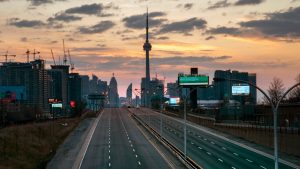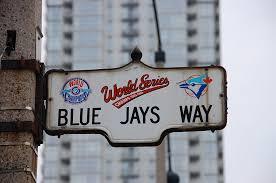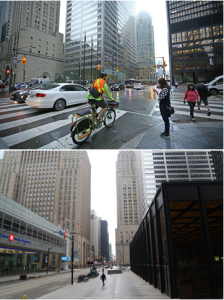 May 2021
May 2021
The COVID pandemic has made our city quieter. We have fewer cars on the road, less congestion and more bicycles.
Some hope to make these changes permanent and build on them.
The 15-Minute City
More cities are embracing the 15-minute city. The idea is to ensure all essential services are within walking distance of home thus eliminating the need to own a car. The process can be slow. Nightclubs and schools may need to serve different purposes throughout the day which may require zoning and bylaw changes. Large stores will require smaller versions.
High-rise communities provide the density to make 15-minute cities practical. In the early days of the pandemic some believed high-density cities and high-rise communities to be more vulnerable to COVID. These beliefs have since been discredited. High-density cities and high-rise communities are not higher risk based on what we know today.
High-rise communities provide the density to make 15-minute cities practical. In the early days of the pandemic some believed high-density cities and high-rise communities to be more vulnerable to COVID. These beliefs have since been discredited. High-density cities and high-rise communities are not higher risk based on what we know today.
Planners want to turn the Yonge-North Corridor, Yonge St. north of Sheppard Ave., to a more pedestrian friendly area by eliminating lanes of Yonge St. and replacing with wider sidewalks, bike lanes and outdoor seating. Many oppose loss of driving and parking space for fear the area would become less accessible, shopping would decline and businesses would suffer. Experience elsewhere suggests otherwise.
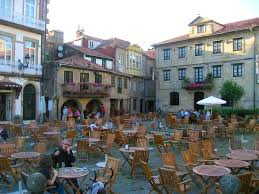 Pontevedra, Spain made the transition more than 20 years ago with the central area turned into a vehicle-free pedestrian space. All surface parking was eliminated and new underground parking created further out. Traffic lights were replaced with roundabouts and speed limits reduced to 30 kilometres an hour. New green space, bike lanes and walking areas were added.
Pontevedra, Spain made the transition more than 20 years ago with the central area turned into a vehicle-free pedestrian space. All surface parking was eliminated and new underground parking created further out. Traffic lights were replaced with roundabouts and speed limits reduced to 30 kilometres an hour. New green space, bike lanes and walking areas were added.
It worked. Pontevedra is thriving, safer, cleaner and looked upon as a model for urban renewal. The streets are filled with people, crime has dropped and business revenues have increased. Other cities are looking more closely at its success.
Roadways and Transit
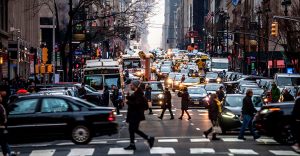 It has been sixty years since Jane Jacobs, Canadian urbanologist, first wrote about communities without expressways.
It has been sixty years since Jane Jacobs, Canadian urbanologist, first wrote about communities without expressways.
Public transit will not disappear. Any transit vehicle, even with physically distanced passengers, makes more efficient use of road space than personal vehicles. Public transit moves more people while freeing up road space for other purposes.
Despite fears of COVID transmission on public transit, there is no evidence of increased risk. Most are not on a vehicle for extended periods, there is a high rate of air exchange and no interaction among most passengers.
For decades we have failed to reduce traffic congestion. Highways continued to be built for people owning cars and voting for those who expanded our roadways. These roads quickly filled up with more cars. Higher parking rates, speed bumps, reduced speeds, and road restrictions during peak hours have made little difference.
The pandemic is viewed by some as an opportunity to change our acceptance of the automobile in urban areas. Today, fewer want to travel distances in cars or on buses, subways, taxis and highways so remain closer to home which has reduced pollution levels.
Rome and Paris are embracing this change. In an effort to improve air quality Rome is building 150 kilometres of bike lanes. One day each month public transit is free and cars are prohibited from most parts of the city centre. A riverside highway has been turned into a riverside park. Paris is creating 1,400 kilometres of bike lanes so almost every street will have one. Nearly 70 percent of surface parking spaces have been eliminated and a central roadway is no longer for cars. Diesel cars will soon be banned.
Public transit will not disappear. Any transit vehicle, even with physically distanced passengers, makes more efficient use of road space than personal vehicles. Public transit moves more people while freeing up road space for other purposes.
Despite fears of COVID transmission on public transit, there is no evidence of increased risk.
Toronto GTA is in the process of building an extended transit system that could last hundreds of years. Current and recent projects include the Eglinton Crosstown, the University line subway extension to Vaughan, and major bus corridors along Highway 7. Others transit projects are expected to follow. If more continue to work from home, peak rush hour volumes will lessen making it possible to adjust schedules to provide better service throughout the day rather than focusing on peak capacities certain times of the day.
